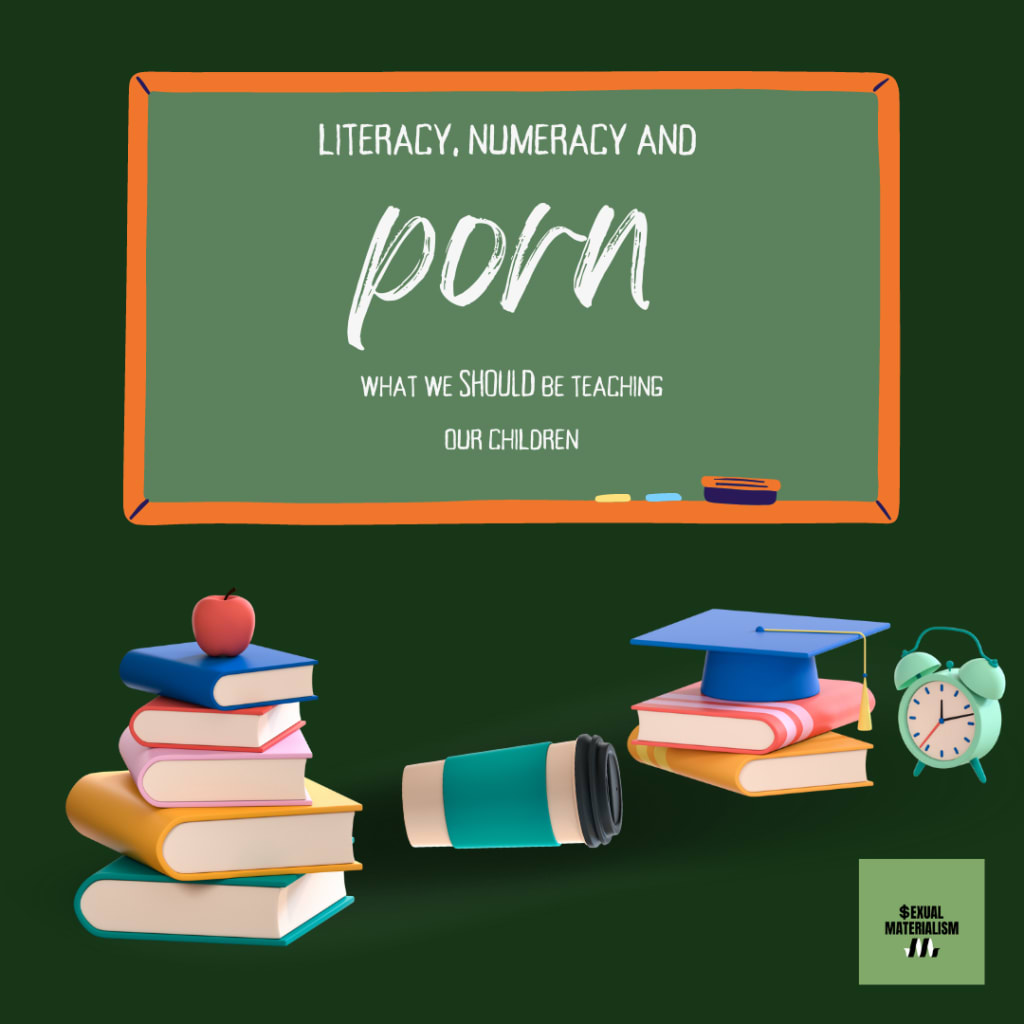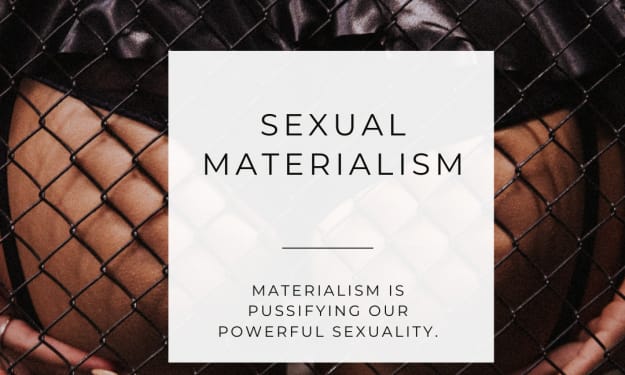Literacy, numeracy and porn -
What we should be teaching our kids.

Our educators are doing a courageous job arming our children with what they need to be safe and sane in this modern world. On top of the fundamentals of English, maths, science and history, curriculums are now providing digital literacy and emotional literacy skills. These latter initiatives aim to strengthen positive, equal, and respectful relationships among women and men and are included in the National Plan to End Violence against Women and Children 2022–2032 (The National Plan) [1]. However, there is one glaring omission from this range of new literacy programs. What about porn literacy?
What is Pornography?
First, it is important to get on the same page about what we mean by pornography. The technical definition of pornography is:
Materials produced principally for the purposes of sexual arousal [2]
This definition sounds completely harmless, and if this is your understanding of pornography, you may wonder what I am making such a fuss about. Just in case you are still living in the seventies, though, pornography has evolved in a deeply disturbing way from the bare-chested beauties gracing the centrefolds of Playboy. It was only a matter of time for these images to be normalised and the viewers to become desensitised. The result? The pornography industry has to up its game and seek more extreme thrills to get and keep its viewer’s attention.

Photo by Frank Busch on Unsplash
There are now two genres of porn that have incredibly dangerous effects:
1. Gozo porn
2. Pseudo-child pornography (PCP)
Gonzo Porn
Gonzo porn is what some people may know as hardcore. It depicts women being debased, dehumanised and physically tortured. And don’t think that access is restricted to such sexual violence. With a simple google search, your children can view women being treated as sexual slaves, with no regard for their physical or emotional wellbeing. In fact, viewers are lured in on the promise that you will see these sluts get what they deserve. Just one search and one click, and your children are in a world of justified cruelty — brutality that becomes linked with sexual pleasure. With one simple search I was confronted with images of women being fisted, ejaculated upon and having every orifice penetrated at once.
Pseudo-child pornography (PCP)
PCP treads a line very close to child pornography. While it uses women over the legal age of 18, they are dressed like toddlers or young girls and are surrounded by toys and other childhood artifacts. They are usually found holding dolls or teddy bears, sucking on lollypops and looking shy. PCP promises the viewer that during this video, they will get to see this innocent young thing become the whore we all know she is. While there is always the argument that the girls shown in these films are adults, there is no doubt that PCP depicts and normalises children as attractive sexual partners.
Porn and Violence
However, it is not just these two genres of porn that cause concern. Research has shown that nearly 90% of all scenes in the top-50 porn films contained at least one aggressive act, being either physical or verbal abuse. Physical abuse such as gagging and slapping occurred in 88% of scenes, and the use of derogatory names was found in 48% of scenes. There were on average 12 acts of violence per scene in these top renting films. There was no resistance to the abuse shown in the films. Instead, victims of the violence displayed pleasure or responded neutrally to the cruelty [3].

Photo by Sydney Sims on Unsplash
The Effects of Porn
What is most disturbing in all of this is our young people’s exposure to porn. The average teenager encounters porn at around 11 years old [4]. Most adolescents will have viewed pornography, with around 93% of boys and 62% of girls regularly exposed to pornographic images [5]. You may think that our children should distinguish between the fantasy that porn portrays and the reality of healthy sexual relations. Unfortunately, you would be wrong. Around 44% of males and 29% of females report wanting to act out what they see in porn [5]. Three-quarters of young women say that pornography increases pressure on girls to act a certain way and increases their level of insecurity in intimate relationships [6]. Around 70% of teenage boys admit that pornography has had a damaging impact on their view of sex and relationships[4].
Porn, it seems, is today’s source of sex education with severe and negative consequences. Research reveals that this consumption strengthens harmful gender stereotypes and increases the perpetration of sexual aggression and tolerance of receiving it. It fills our children’s minds with lies about sexual relations. For example, it creates the impression that women are always up for sex and are always willing to do what a man wants, regardless of how painful, harmful or humiliating it may be [7]. While parents and educators may desire to create an environment of gender equality and respect, porn is much louder than the positive messages. We all know that it is generally the loudest voice that wins.
Porn Is A Precursor to Child Sexual Abuse
Given the scale of the porn industry, good intentions don’t stand a chance. The easy access to porn on the internet means that adolescents and young adults can consume a much greater quantity of pornography than ever before. In addition, in an attempt to keep things fresh and enticing, they are also being drawn into images that are increasingly more violent and bizarre. Porn is desensitising our young people to violence. The research also shows that exposure to violent porn quickly escalates viewing preferences to even more violent and bizarre sexual practices. Alarmingly, the research also shows that PCP increases the demand for real child pornography and provides men with both a blueprint and stimulus to undertaking child sexual abuse [8].
Disturbing Double Standards
In her forthright and shocking book Pornland [9], Gail Dines makes a wonderful point. We would never allow these practices in the public domain if they were conducted based on race or religion. We would not permit images of torture, restraint, physical violence, and degradation to African-Americans or Jews. So why the hell are we allowing these images of women to be freely circulated without reprimand? It is time to get angry!
We Need Porn Literacy
Unfortunately, just getting angry about it is not going to solve the problem. The protests and burning of bras in the sexual revolution of the ’70s didn’t get us very far. All the anger without associated education resulted in a greater sexualisation of women. So, we need a new approach and one that is based on the reality of our modern world and our children’s digital experiences. We need porn literacy [10].

Photo by Compare Fibre on Unsplash
The world literacy means:
having competence and knowledge in something.
Porn literacy then is viewing porn as an informed consumer and understanding that it does not represent healthy or respectful relationships. Just like we teach our children the dangers of drugs, porn literacy provides our children with knowledge about the harm that porn can cause. It helps them understand that it can damage their levels of respect for themselves, women generally, and their ability to have happy intimate relationships. Porn literacy is not aimed at stopping people from viewing porn, nor is it there to judge people who view it. It is there to counterbalance the harmful normalisation of violence and perpetuation of negative gender stereotypes. It brings out in the open discussions about the fabricated and exploitative nature of porn. It provides a real opportunity to make our kids smarter about what they consume. With knowledge comes power, and porn literacy can give our children the power to create positive sexual relationships.
Engaging Our Kids Smarts
I think you would agree that our kids are pretty damn smart. Our role is to provide the tools and the opportunity to allow them to use their smarts to make this world a better place. Porn literacy is a tool that we can use to allow our children to think critically about what the images they see are saying about women, men and sexuality. It gives them the ability to question the sex education they are receiving from porn and opens the doors to honest conversations that can change the lives of future generations of girls and boys.

Photo by Kuanish Reymbaev on Unsplash
What This Means For The National Plan
The National Plan admits that pornography reinforces stereotyped sexual attitudes and contributes to harmful sexual behaviours. Pornography normalises brutality, oppression and possession, all of which are precursors to domestic violence. And yet, porn has become the proxy for sex education for our kids. Where then is the plan for porn literacy so that our children can become informed consumers and begin intelligent conversations about sexuality and respect? If the National Plan is serious about addressing the precursors to violence against women and children, then it needs to add a program of porn literacy to its toolkit.
Note from the author
I have come across the dangers of porn through my work as Series Executive Producer of the Future Sex Love Art Projekt with Missy Jubilee. For a heart-wrenching account of the relationship between porn and child sexual abuse, watch the movie SINNER.
References
[1] https://engage.dss.gov.au/draft-national-plan-to-end-violence-against-women-and-children-2022-2032/
[2] Barker, M. J. (2018). The Psychology of Sex (The Psychology of Everything) (1st ed.). Routledge.
[3] Bridges, A. J., Wosnitzer, R., Scharrer, E., Sun, C., & Liberman, R. (2010). Aggression and Sexual Behavior in Best-Selling Pornography Videos: A Content Analysis Update. Violence Against Women, 16(10), 1065–1085. https://doi.org/10.1177/1077801210382866
[4] Havey, A., Puccio, D., & Thomas, K. S. (2017). Sex, Likes and Social Media: Talking to Our Teens in the Digital Age. Vermilion. Page 94.
[5] Lis, L. (2020). No Shame: Real Talk With Your Kids About Sex, Self-Confidence, and Healthy Relationships. Page 151.
[6] Havey, A., Puccio, D., & Thomas, K. S. (2017). Sex, Likes and Social Media: Talking to Our Teens in the Digital Age. Vermilion. Page 102.
[7] Dines, G. (2011). Portland: How Porn Has Hijacked Our Sexuality (1st ed.). Beacon Press. Page xxxiii.
[8] Quayle and Taylor, “Child Pornography and the Internet” as quoted in Dines, G. (2011). Portland: How Porn Has Hijacked Our Sexuality (1st ed.). Beacon Press. Page 159.
[9] Dines, G. (2011). Portland: How Porn Has Hijacked Our Sexuality (1st ed.). Beacon Press. Page 88.
[10] Teaching Porn Literacy. (2021). American Psychological Association. Retrieved January 26, 2021, from https://www.apa.org/monitor/2021/03/teaching-porn-literacy
Find out more at www.sexualmaterialism.com
About the Creator
Belinda Tobin
Author. Series Executive Producer for the award-winning Future Sex Love Art Projekt. Founder of The 3rd-Edge The Addiction Healing Pathway.






Comments
There are no comments for this story
Be the first to respond and start the conversation.